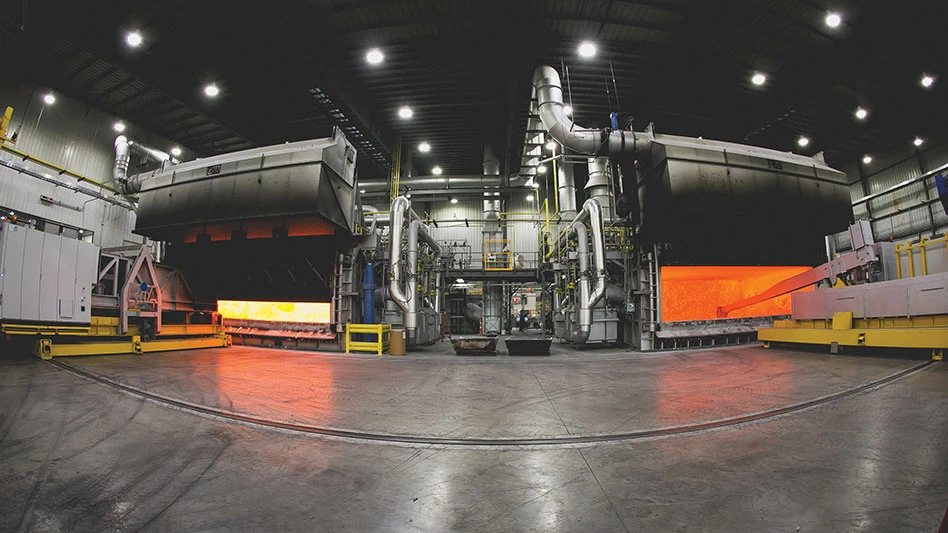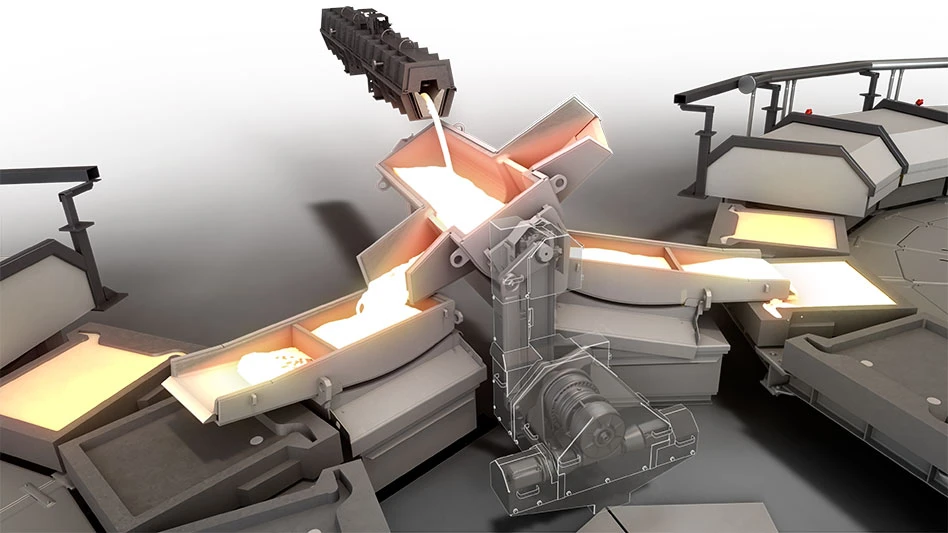Over the past month or so, a significant amount of activity has been occurring among specialty metals producers in North America. RMI Titanium Co., Niles, Ohio, recently signed a letter of intent to acquire 90 percent of Galt Alloys, Canton, Ohio. The agreement calls for Galt to build a new scrap preparation facility, a plasma consolidation and a plasma hearth furnace.
Also, early in June, Inco Ltd., New York, announced plans to sell its Inco Alloys International division to Haynes International, a producer of nickel alloys, located in Kokomo, Ind.
This activity has brought some renewed publicity to a segment of the metals industry that has been showing steady growth over the past several years.
Compared to larger-volume materials such as steel and aluminum, end markets for specialty metals are somewhat limited. Despite this, there has been some diversification of end markets, especially for nickel and stainless steel. According to the United States Geographic Survey, the transportation industry consumes 29 percent of the stainless steel used in the U.S.; the chemical industry, 14 percent; electrical equipment, 10 percent; construction, 9 percent; fabricated metal products, 8 percent; petroleum, 8 percent; machinery, 7 percent; household applications, 6 percent.
As for growth potential, recent figures show U.S. demand for primary nickel increased by 13 percent between 1994 and 1995, while the growth in stainless steel was up, but to a lesser degree.
On the recycling side, about 55,000 tons of nickel was recovered from purchased scrap in 1996, according to the USGS. This represented about 32 percent of reported consumption for the year.
The United States’ only nickel smelter, located near Riddle, Ore., was operating at full capacity in 1996. Of the 164 facilities reporting nickel consumption to the USGS last year, the principal consuming state was Pennsylvania, followed by West Virginia and New Jersey. About 46 percent of the primary nickel consumed went into stainless and alloy steel production, 33 percent into nonferrous alloys and superalloys, 14 percent into electroplating, and 7 percent into other uses.
For titanium, the end markets are much less diverse, with more than 75 percent of the titanium in the U.S. used for the aerospace industry. A secondary end market, the sporting goods industry, accounts for a sizable percentage. This secondary market has captured a significant amount of interest by the consumer public over the past several years, and could be a precursor for greater inroads by the titanium industry into other consumer products.
PROMISING MARKET
For handlers of these commodities, a snapshot of the industry shows good promise, despite some short-term problems that could create problems for scrap processors. Since a lion’s share of nickel production goes into the manufacture of stainless steel, the two materials move, to a degree, in synch. "As stainless goes, so goes nickel," according to one scrap processor.
According to Peter Kuck, a nickel specialist with the U.S. Geological Survey, Washington, D.C., there has been a fair amount of price volatility over the past year. London Metal Exchange prices for nickel went from slightly more than $8,000 a metric tons in May 1996 to about $7,500 a metric ton in May 1997.
The volatility in prices, according to Kuck, can be attributed to a number of factors, including speculation by banks, the import of nickel from outside the United States – most notably from the Russian Republic – and even the recent strike at the Inco Ltd., nickel mining complex and smelting operation in Sudbury, Ontario. The strike, begun early June, at presstime had had little impact on price and demand. In fact, according to several commodity watchers, the price actually continued to decline despite the strike. Longer term, if the strike continues for any length of time, it will certainly have a downstream impact on markets. LME stocks may be reduced, which could then push the nickel price up.
Despite the recent softening in nickel prices, a number of scrap processors feel supply and demand are in balance. This follows the last several years when supply and demand fluctuated between an oversupply and shortage.
The future for nickel and stainless steel looks bright, according to Barry Hunter, senior vice president of Nap-Key Stainless, a joint venture of Naporano and Keywell, Elizabeth, N.J. Some new applications are coming on stream, he says, and while markets have been slightly softer, there appears to be something of a balance taking place. This may indicate that while the strike is pulling nickel off the market, there is additional nickel being delivered from other sources, according to Hunter.
While this swing seems significant, it pales in comparison to the late 1980s when prices dropped by more than 100 percent, according to another large handler of nickel scrap.
Despite the strike, new capacity is expected to push production and drive market share over the next several years. Inco is working on the Voisey’s Bay nickel deposit in Labrador, Newfoundland. The expansion of the Voisey’s Bay project, along with a new Raglan mine in Quebec, will add a significant amount of additional tonnage onto the world market.
Nevertheless, primary nickel demand is likely to outpace production next year, even with the new expansions coming on line, according to Brian Shea, marketing manager of Sherritt International Corp., Toronto. Shea spoke during the annual conference of the Canadian Association of Recycling Industries in Whistler, B.C. According to Shea, the primary nickel consumption is expected to reach 911,000 tons this year, compared to around 850,000 tons last year.
This growth is being met by increased use of scrap, which has grown around 5 percent a year for the past five years. Shea added that it even grew by 4.6 percent during 1995, while the use of primary metal declined by 4.6 percent.
In the near future, there will likely be significant price movements for nickel and stainless. However, the ability of the LME to act as a clearinghouse should keep prices for these base metals from moving too sharply either up or down.
"In the future, there will be lots of volatility, but prices will be pretty constant," says Kuck.
Helping keep movement stable are a host of new projects being developed throughout the world. At the same time, there aren’t any indications that other nickel producing locations will be shuttering their operations. This bodes well for strong and growing nickel demand throughout the next several years, says Kuck.
LOOKING DOWN THE ROAD
The nickel/stainless steel market is expected to hold its present position through the duration of the year. But because the metals are commodities, a host of factors – both large and small – could have an impact on the market.
For example, if the Russian Republic pulls a significant additional amount of nickel off the market, there could be some tightening in supplies. The strike in Canada, if it continues for an extended period of time, could also cause some tightness of supply and corresponding price increases.
New markets include the possibility of greater demand for nickel cadmium batteries, which could increase the overall demand for nickel, as well as the growing interest in using stainless steel for architectural purposes. This stainless steel market holds great promise for many stainless steel processors, although most feel this will be a long-term project, and is not likely to become a major factor in the market over the next several years.
Where does scrap stainless fall in this picture? It will continue to play a role, although the possibility of substitution between virgin stainless steel and scrap stainless should work to keep both grades from overheating in price.
TITANIUM SEEKS MARKETS
While nickel and stainless are seeing some possible avenues for new demand, titanium is still dominated by one market. With around 75 percent of all the titanium going into the manufacturing of airplanes, helicopters and other large items in the aerospace industry, the growth of titanium and titanium scrap will be heavily influenced by this segment of the world economy. For example, if a company like Boeing, Seattle, had a cutback in orders, this could have a dramatic effect on the titanium market.
A lesser amount of titanium is used in various industrial and commercial applications, such as chemical processing and pulp and paper. The material is also used in some sports equipment, such as racing cars, sleds, tennis rackets, golf clubs and bicycles; medical applications such as prosthetic devices; and consumer applications such as jewelry and eyeglasses.
Although demand for high grades of titanium has been fairly strong, says Jim Nathan, vice president of trading for CBC Trading, a division of Charles Bluestone Co., Pittsburgh, prices for the material are down slightly at the present. He alludes to the recent oversupply of titanium golf clubs as a factor. The golf club market, which has been a fast-growing new source of demand for the material, has recently slowed. According to Nathan, there is an ample oversupply of titanium golf clubs available, which is slowing new production and lessening demand.
The use of titanium in golf clubs has been one of the big successes for the titanium industry over the past several years. As a number of scrap processors and brokers point out, extending the end markets for titanium, especially into the consumer industry, will give some better protection against relying on one industry to be the primary consumer of the material.
While golf clubs are one step, other avenues, especially those dedicated to consumer products, will benefit the industry. However, these alternate sources have yet to develop to any great degree. Several scrap handlers note that cooking utensils for the camping industry is one alternative. This area is only now starting to grow, and still makes up a small part of the overall titanium market.
Several companies are adding more titanium scrap processing capacity using new technology. For example, Oregon Metallurgical Corp. is looking to add electron beam furnaces.
Additionally, Titanium Hearth Technologies, Morgantown, Pa., is looking to add a furnace which is expected to bring an additional 20 million pounds of titanium onto the market.
"I think markets are good – I am very bullish on titanium," says Mark Winter, vice president of titanium sales for Suisman Titanium Corp., Hartford, Conn. "Demand has been pretty strong over the last year. There is a gradual easing of pressures on titanium. It is essentially moving forward."
Winter is in favor of the titanium industry measuring primary production in terms of tons rather than pounds, like a more common metal such as steel. "Thinking in bigger terms will encourage the industry to ramp up production," he says. "If we can produce titanium in enough quantity in a cost-competitive way, people will see the benefits of the material – such as the light weight – and begin to use it in increasingly varied applications."
Industrial prompt scrap metal recycled by the titanium industry was about 25,000 tons in 1996.
Additionally, the estimated use of titanium as scrap and in the form of ferrotitanium made from scrap by the steel industry was 4,700 tons; by the superalloy industry, 730 tons; and in other industries, 510 tons. Old scrap reclaimed was around 200 to 400 tons.
The price of titanium scrap has come down around 25 percent recently. This decline, rather than a cause for alarm, is actually a signal that markets are improving and increasing in stability, according to several market watchers.
RELATIVE STRENGTH
Indicative of the health of the specialty metals market is its current relative strength, as the summer months often are a time when European companies take extended vacations, generation declines in the United States and domestic consumers have fuller inventories and aren’t looking for as much material. However, for this year, through the first half, movement continues to be strong, and prices are stable.
With few signs of any change in the move, the movement and markets for these materials should remain steady through the rest of this year.
While the recycling of stainless steel scrap enjoys a well-entrenched market, several processors note a strong market also exists for reusable stainless steel. "It’s a growing part of our business," says a West Coast nickel/stainless steel processor.
The author is senior editor of Recycling Today.

Explore the July 1997 Issue
Check out more from this issue and find your next story to read.
Latest from Recycling Today
- Fenix Parts acquires Assured Auto Parts
- PTR appoints new VP of independent hauler sales
- Updated: Grede to close Alabama foundry
- Leadpoint VP of recycling retires
- Study looks at potential impact of chemical recycling on global plastic pollution
- Foreign Pollution Fee Act addresses unfair trade practices of nonmarket economies
- GFL opens new MRF in Edmonton, Alberta
- MTM Critical Metals secures supply agreement with Dynamic Lifecycle Innovations






